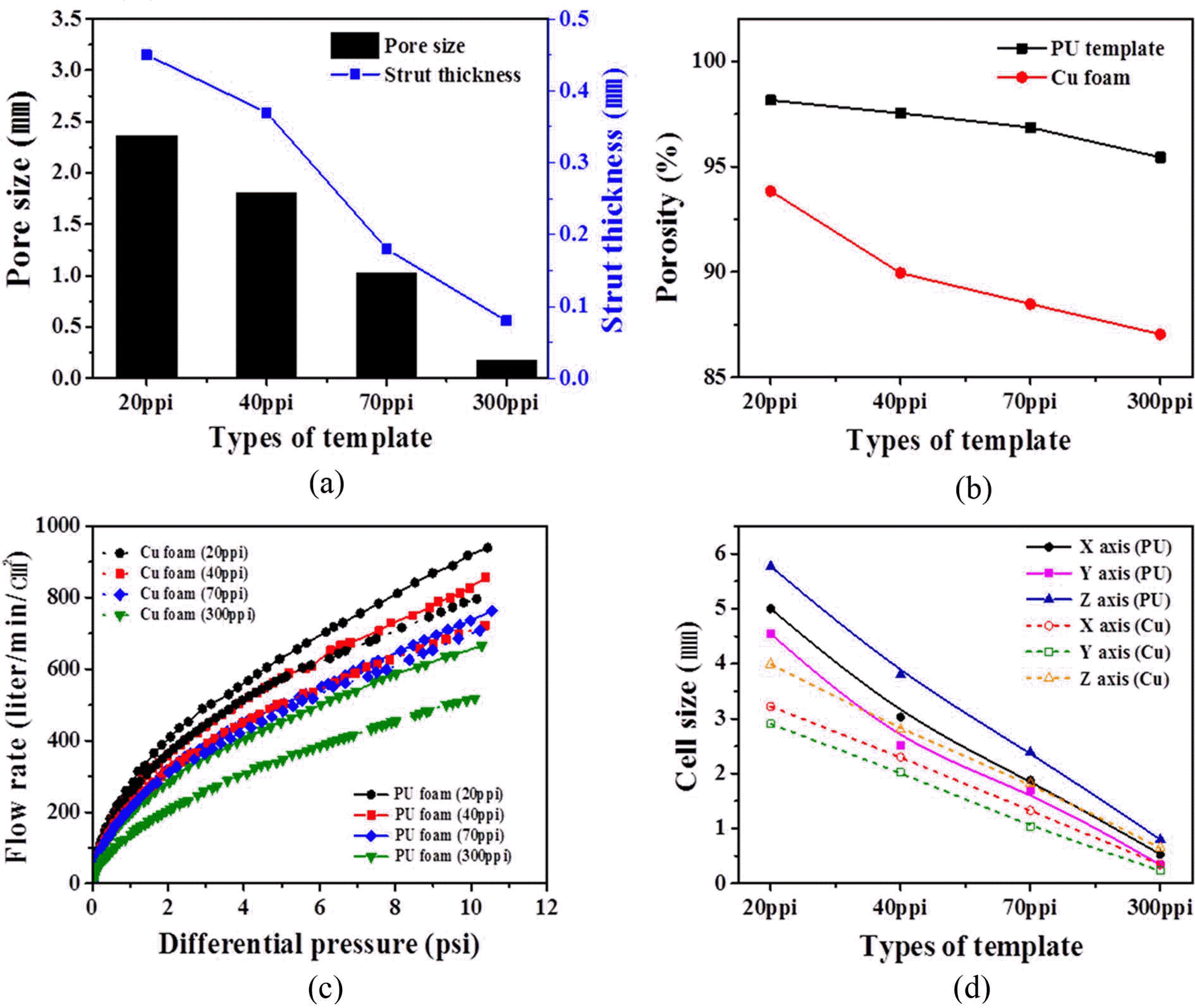Articles
- Page Path
- HOME > J Korean Powder Metall Inst > Volume 22(2); 2015 > Article
-
ARTICLE
- Fabrication and Pore Characteristics of Cu Foam by Slurry Coating Process
- Dahee Park, Eun-Mi Jung, Sangsun Yang, Jung-Yeul Yun*
-
Journal of Korean Powder Metallurgy Institute 2015;22(2):87-92.
DOI: https://doi.org/10.4150/KPMI.2015.22.2.87
Published online: March 31, 2015
- * Corresponding author: Jung-Yeul Yun, TEL: +82-55-280-3561, FAX: +82-55-280-3289, E-mail: yjy1706@kims.re.kr
• Received: April 1, 2015 • Revised: April 20, 2015 • Accepted: April 22, 2015
© Korean Powder Metallurgy Institute
This is an Open-Access article distributed under the terms of the Creative Commons Attribution Non-Commercial License (http://creativecommons.org/licenses/by-nc/3.0) which permits unrestricted non-commercial use, distribution, and reproduction in any medium, provided the original work is properly cited.
- 785 Views
- 4 Download
- 1 Crossref
Abstract
- Metallic porous materials have many interesting combinations of physical and geometrical properties with very low specific weight or high gas permeability. In this study, highly porous Cu foam is successfully fabricated by a slurry coating process. The Cu foam is fabricated specifically by changing the coating amount and the type of polyurethane foam used as a template. The processing parameters and pore characteristics are observed to identify the key parameters of the slurry coating process and the optimized morphological properties of the Cu foam. The pore characteristics of Cu foam are investigated by scanning electron micrographs and micro-CT analyzer, and air permeability of the Cu foam is measured by capillary flow porometer. We confirmed that the characteristics of Cu foam can be easily controlled in the slurry coating process by changing the microstructure, porosity, pore size, strut thickness, and the cell size. It can be considered that the fabricated Cu foams show tremendous promise for industrial application.
- Metallic foam consists of a single network structure which interconnects the outer surface to the inner body, and which exhibits controlled pore size, low relative density, and high porosity. For this reason, metallic porous materials have many interesting combinations of physical and geometrical properties with very low specific weight and high gas permeability [1]. Previously, ceramic foams such as Al2O3, SiC, and ZrO2 were usually studied for use as porous materials in industrial application [2]. However, metallic foam can be easily controlled in mechanical and pore properties compared to ceramic materials [1, 3]. In particular, Cu foam as a metallic porous material has been researched in use as a new material for heat sink and dust or fluid filters [2-5]. A metallic foam was first fabricated by Sosnik in 1948 [6], and until now many researchers have developed metallic foam by using various techniques such as thermal decomposition [7], investment casting [8], and chemical vapor deposition [9]. Fabrication of porous materials with specific functionalities in an efficient process is still a great challenge. In particular, pore characteristics including porosity, pore size, air permeability, and strut thickness are a key factor in improving the performance of porous materials [10]. Thus, the slurry coating process has received attention as a proper technique to fabricate porous materials [11-12]. This process has the advantage of being a simple method to coat complicated structures as well as being cost effective. Recently, Fe foam was successfully fabricated by a slurry coating process and studied for its pore characteristics [13].
- In this study, we researched Cu foam as a metallic porous material. The Cu foam was fabricated by a slurry coating process involving changing the coating amount and the type of polyurethane foam which was used as a template. The purpose of this work was to find the optimized coating times and replicate the shape of templates. Heat-treatment steps were carried out to remove the binder, template, and interconnect in the strut, keeping the remaining morphology of the PU (polyurethane) foam after de-binding and sintering at high temperature. The processing parameters and pore characteristics were observed in order to identify the key factors of the slurry coating process and to enhance the morphological properties of the fabricated Cu foam. Hence, we focused on pore characteristics such as pore size, porosity, strut thickness, cell size, and air permeability, optimizing the coating times and template size with over 90% porosity for the fabricated Cu foam.
Introduction
- For the preparation of the Cu foam, the following materials were used: Cu powder (48.77 μm, Changsung, Korea), polyvinyl alcohol (PVA 1500[CH2CH(OH)], Junsei, Japan), and polyurethane foam (20, 40, 70, 300 ppi, Ecotech, Korea). The Cu porous foam was fabricated by a slurry coating process. The process is described schematically in Fig. 1. PVA 2 wt% solution was prepared by mixing the 2 g polyvinyl alcohol and 98 mL distilled water as a binder and then Cu slurry was prepared by mixing the Cu powder and the PVA 2 wt% solution. Distilled water was used as a solvent, and the slurry was mixed for three minutes with a Cu powder-to- PVA solution weight ratio of 7:3. Cell size of polyurethane foam was 20, 40, 70, and 300 ppi (pore per inch) and we used 40 ppi polyurethane foam for slurry coating times. To coat the Cu slurry on the polyurethane foam, it was fully dipped into the Cu slurry and then dried at 50°C for three hours. After drying, a de-binding step was carried out at 700°C for three hours at a 3°C/min heating and cooling rate for the Cu slurry coated on the polyurethane foam, through which the binder and polyurethane foam could be removed, leaving the final shape of the foam. The Cu porous foam was finally sintered at 1000°C for three hours in H2 atmosphere at a 5°C/min heating and cooling rate. The pore characteristics of Cu porous foam were investigated by scanning electron micrographs (JSM-5800, JEOL, Japan), particle size analyzer (LS I3 320, Beckman coulter), and micro-CT analyzer (Skyscan 1272, Bruker). The air permeability of Cu foam was measured by capillary flow porometer (CEP1200AEL, PMI, USA), and the phase of Cu powder and Cu foam were investigated by X-ray diffraction analyzer (D/Max 2200, Rigaku).
Experimental
- The typical SEM photographs of Cu powders are shown in Fig. 2(a). The initial Cu powders as raw materials show an irregular shape with the mean size of these particles 48.77 μm. Fig. 2(b) and (c) show the respective X-ray diffraction patterns of Cu initial powder and Cu foam fabricated by a slurry coating process. It was indicated that the Cu powder and Cu foam contained only Cu peaks, which showed that there was no formation of impurities and new phases after the slurry coating process. Fig. 3 shows SEM images of the fabricated Cu foam depending on the slurry coating 1 to 5 times. As seen in Fig. 3, a gradual increase in the strut thickness and the uniform necking of Cu foam correlating with the coating times was observed. In contrast, the pore size decreased with pore blocking because the amount of Cu slurry on unit area of the foam increased. Fig. 4(a) also shows a similar tendency with SEM morphologies (Fig. 3). The pore sizes are 2.01, 1.78, 1.74, 1.68, and 1.48 mm with a strut thickness 0.57, 0.73, 0.79, 0.83, and 1.19 mm respectively.
- (a) SEM images of Cu powder at low (x100) and high (x1000) magnifications and X-ray diffraction patterns of (b) Cu raw powder and (c) Cu foam fabricated by a slurry coating process.
- SEM images of Cu foam at low (x20) and high (x100) magnifications according to the coating times (a) 1 time, (b) 2 times, (c) 3 times, (d) 4 times, and (e) 5 times.
- Pore characteristics of the Cu foam (a) pore size and strut thickness, (b) porosity, (c) flow rate as a function of differential pressure, and (d) cell size depending on the coating times.
- The pore characteristics of the fabricated Cu foam are given in Fig. 4 as determined by the results of micro-CT analysis [13]. As shown in Fig. 4(b), porosities measured for the Cu foam with slurry coating 1 to 5 times are 92, 91, 85, 80, and 69%, respectively. This means that porosity of the fabricated foam decreased when the slurry coating times increased. The air permeability of the Cu foam can be seen in Fig. 4(c) in which flow rate was measured according to differential pressure. Compared to the polyurethane template, Cu slurry coated foam shows a gradual decrease in air permeability with an increase in coating time. This result is consistent with the explanation obtained in Fig. 4(a). Data in Fig. 4(d) displays cell size changes of the Cu foam for each axis being dependent on the coating times. The cell size is defined by the average height of the cells in the foams [14]. As detailed in Fig. 4(d), a decrease in cell size was observed regardless of the axis. When the coating time was increased, the pore size is inversely proportional to the strut thickness. Since cell size is related to the whole open cell structure, the cell size of Cu foam evenly diminished according to the decrease in pore size [1, 15, 16]. As can be seen in the results, a similar tendency was observed in all analyzed data, with no sudden changes. As an important factor in the porous materials, porosity more than 90% is good for application [1]. When considering porosity and pore size with strut thickness, Cu foam with two coating times makes a more optimized foam.
- As a second stage, we fabricated Cu foam by using the same amount of Cu slurry for each different type of polyurethane foam as the template. The Cu foam, which replicates the shape of the polyurethane template but with a different pore size, was analyzed after de-binding and sintering. As a result, Fig. 5 displays SEM images of PU foam at 20, 40, 70, and 300 ppi (pores per inch) and the fabricated Cu foam depending on the cell size of PU foam. As seen in the images, all types of Cu foam have completely replicated the shape of the template and necked uniformly. In contrast, when the cell size of PU foam was small, more pore blocking in the foam was observed because the amount of Cu slurry on the unit area of PU foam increased. Fig. 6(a) indicates that strut thickness of the fabricated Cu foam sharply decreased proportional to the pore size. It appears a similar trend with SEM morphologies in Fig. 5. The pore characteristics of the fabricated Cu foam are shown in Fig. 6 as determined by results of micro-CT analysis. As detailed in Fig. 6(b), porosities measured for the Cu foam at cell sizes 20, 40, 70, and 300 ppi are 94, 90, 88, and 87% respectively. When considering the initial PU template at 20, 40, 70, and 300 ppi, porosities are 98, 97, 96, 95% respectively, indicating the porosities after coating with the slurry diminishing approximately 4-8%. This means that porosity of the fabricated foam uniformly decreased proportional to the cell size of the PU template despite the Cu slurry coating on the template. Fig. 6(c) shows the air permeability of the Cu foam with the flow rate measured as a function of the differential pressure. Compared to the polyurethane template, air permeability of Cu foam was lower, but the fabricated Cu foam reveal a gradual increase in air permeability with a differential pressure when increasing the pore size of the polyurethane template. This result is related to the porosity obtained in Fig. 6(b). The flow rate at the same pressure increases when porosity increased according to the pore size of the foam. Fig. 6(d) shows that cell size changes in the Cu foam for each axis correlates with the pore size of foam. As displayed in Fig. 6(d), the reduction of cell size was observed regardless of the axis. It appears that the whole size of the fabricated Cu foam shrunk after heat treatment [17, 18]. When considering the pore characteristics of Cu foam, we concluded that the 20 and 40 ppi PU foam is appropriate to make the Cu foam via a slurry coating process because it provides good air permeability and more than 90% porosity.
Results and Discussion
Fig. 2.
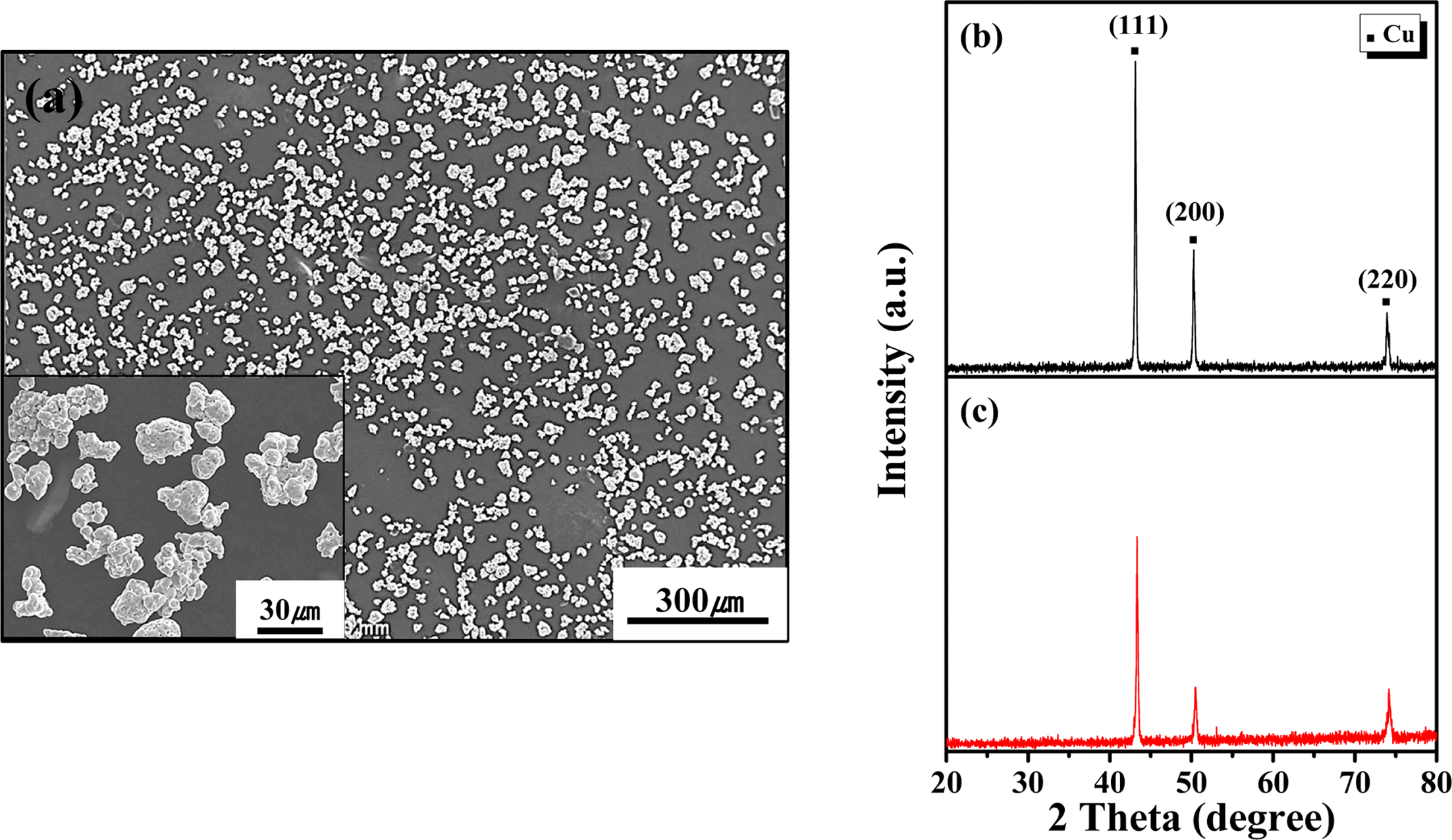

Fig. 3.


Fig. 4.
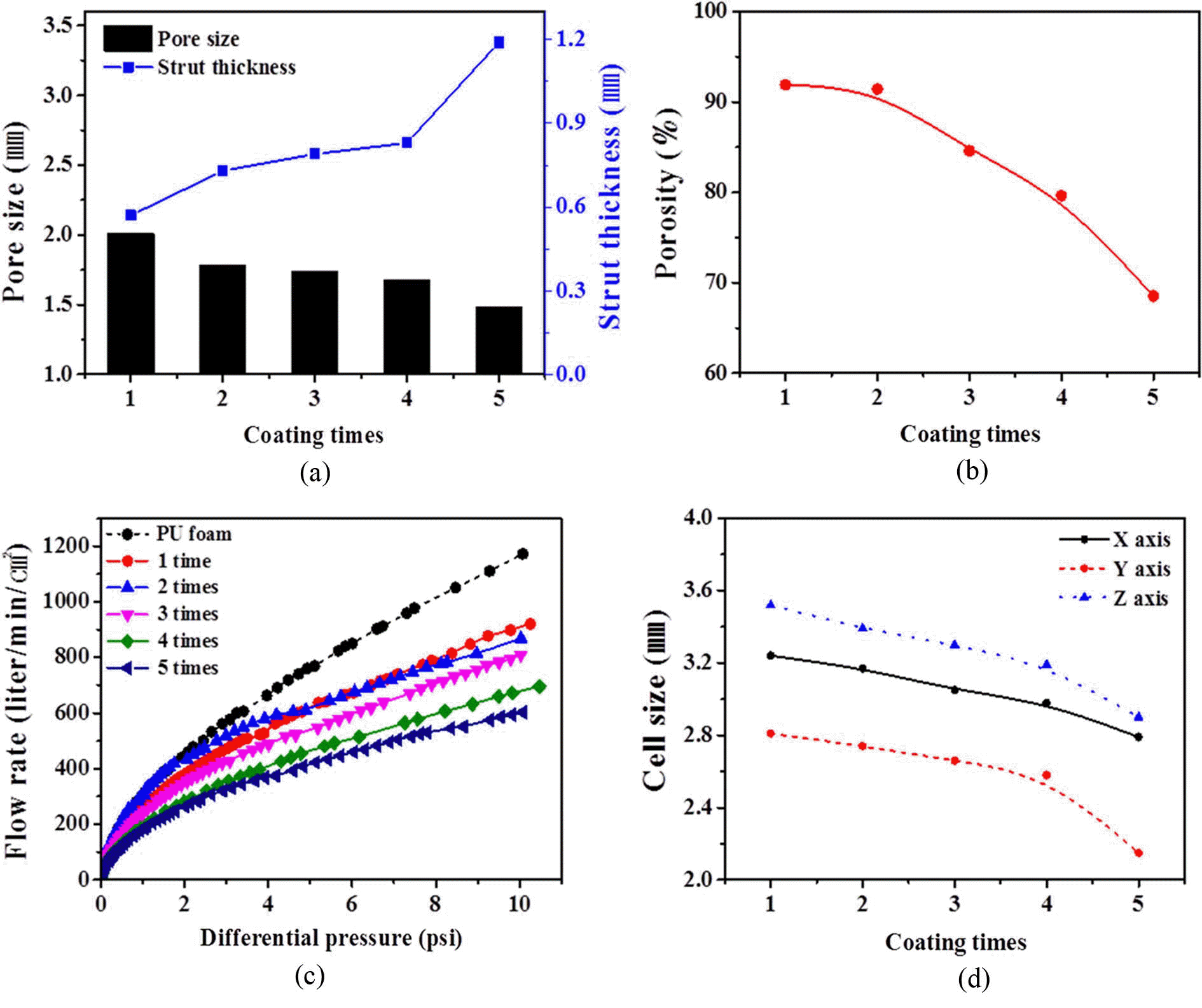

- In the present study, a slurry coating process was used to fabricate Cu foams based on slurry coating times and polyurethane templates of various cell sizes. The pore characteristics of Cu foam were observed after heat treatment. For Cu foams, the increase in the strut thickness and the uniform necking of Cu foam were observed against an increase in the coating times. When considering pore characteristics, two times of slurry coating is appropriate to the uniform Cu foam. And Cu foam was fabricated based on the polyurethane template at the various pore sizes of 20, 40, 70, and 300 ppi. When the pore size of PU foam was small, more pore blocking in the foam was observed because the amount of Cu slurry on the unit area of PU foam increased. In addition, strut thickness of the fabricated Cu foam sharply decreased proportional to the pore size of the foam. When considering the pore characteristics of the Cu foam, we concluded that the 20 and 40 ppi PU foam is appropriate to make the Cu foam via a slurry coating process. In conclusion, we confirmed that the characteristics of Cu foam can be easily controlled in the slurry coating process by changing the microstructure, porosity, pore size, strut thickness, and the cell size.
Conclusions
-
Acknowledgements
- This work was supported by a grant from the Fundamental Research Program for the Korea Institute of Materials Science (KIMS) and the Fundamental R&D Program for Strategic Core Technology of Materials, funded by the Ministry of Trade, Industry & Energy, Republic of Korea.
Acknowledgements
- 1. G. J Davies and S. J Zhen: J. Mater. Sci., (1983) 18 1899.ArticlePDF
- 2. H. J Hwang and J. W Moon: J. Korean Ceram. Soc., (2004) 41 229.
- 3. K Araki and J. W Halloran: Am. Ceram. Soc., (2005) 88 1108.Article
- 4. Y. H Koh, J. H Song, E. J Lee and H. E Kim: J. Am. Ceram. Soc., (2006) 89 3089.Article
- 5. H. C Shin and M Liu: Chem. Mater., (2004) 16 5460.Article
- 6. B Sosnick, USA US 2434775. (1948.
- 7. J. C Elliott, USA US 2751289. (1956.
- 8. M. F Ashby, A. G Evans, N. A Fleck, L. J Gibson, J. W Hutchinson and H. N. G Wadley, A Design Guide Butterworth Heinemann Oxford, (2000) Metal Foams.
- 9. J Babjak, V. A Ettel and V Paserin, USA US 4957543. (1990.
- 10. S. D Kim, S. H Hyun, J Moon, J. H Kim and R. H Song: Journal of Power Soc., (2005) 139 67.Article
- 11. P. R Lavery, A. C Banner and J Pollock, USA US 6620518. (2003.
- 12. S Zha, Y Zhang and M Liu: Solid State Ionics., (2005) 176 25.Article
- 13. J. H Choi, E. M Jeong, D Park, S Yang, Y. D Hahn and J. Y Yun: J. Korean Powder Metall. Inst., (2014) 21 4.
- 14. W. Y Jang, A. M Kraynik and S Kyriakides: Int. J. Solids. Structures., (2008) 45 1845.Article
- 15. P. R Onck, E. W Andrews and L.J Gibson: Int. J. Mech. Sci., (2001) 43 681.Article
- 16. C Chen and N. A Fleck: J. Mech. Phys. Solids., (2002) 50 955.Article
- 17. A Paul, T Seshacharyulu and U Ramamurty: Scr. Mat., (1999) 40 809.Article
- 18. U Ramamurty and A Paul: Acta. Mat., (2004) 52 869.Article
REFERENCES
Figure & Data
References
Citations
Citations to this article as recorded by 

- Preparation and comparative evolution of mechanical behavior of Fe and Fe2O3 foams and their polymer composites
Vemoori Raju, Roy Johnson, Asit Kumar Khanra
Journal of Alloys and Compounds.2018; 750: 71. CrossRef
-
 Cite this Article
Cite this Article
- Cite this Article
-
- Close
- Download Citation
- Close
- Figure
- Related articles
-
- Fabrication and Pore Characteristics of Metal Powder Filters with a Cross-Sealed Honeycomb Shape Using Material Extrusion Additive Manufacturing
- Preparation and Microstructural Characteristics of Ti Nanopowder by Ball Milling and Dehydrogenation of TiH2 Powder
- Fabrication and Sintering Behavior Analysis of Molybdenum-tungsten Nanopowders by Pechini Process
- Fabrication and Characteristics of YSZ-TiC Ceramics Composite by Using Hot Pressing
Fabrication and Pore Characteristics of Cu Foam by Slurry Coating Process
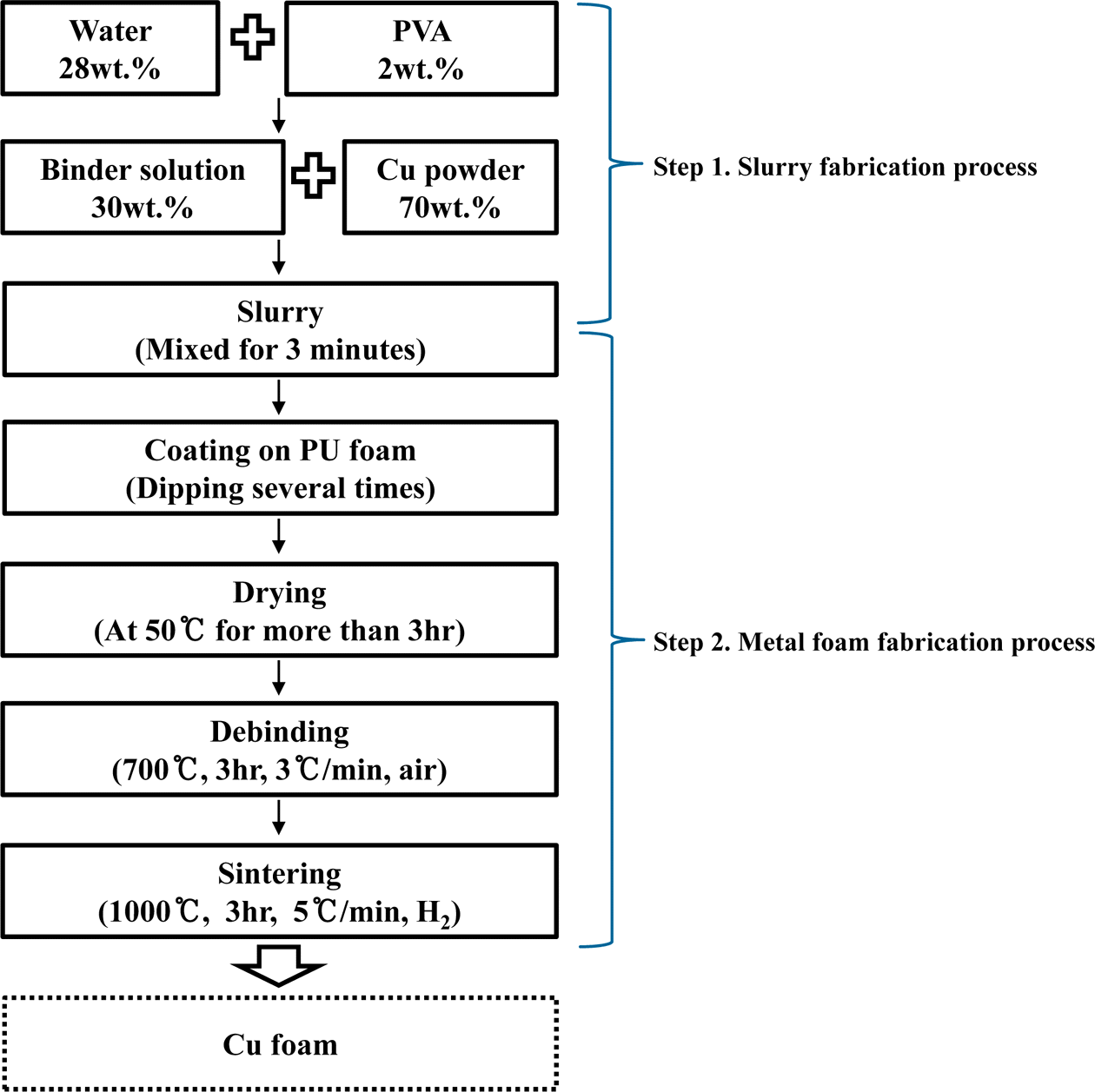



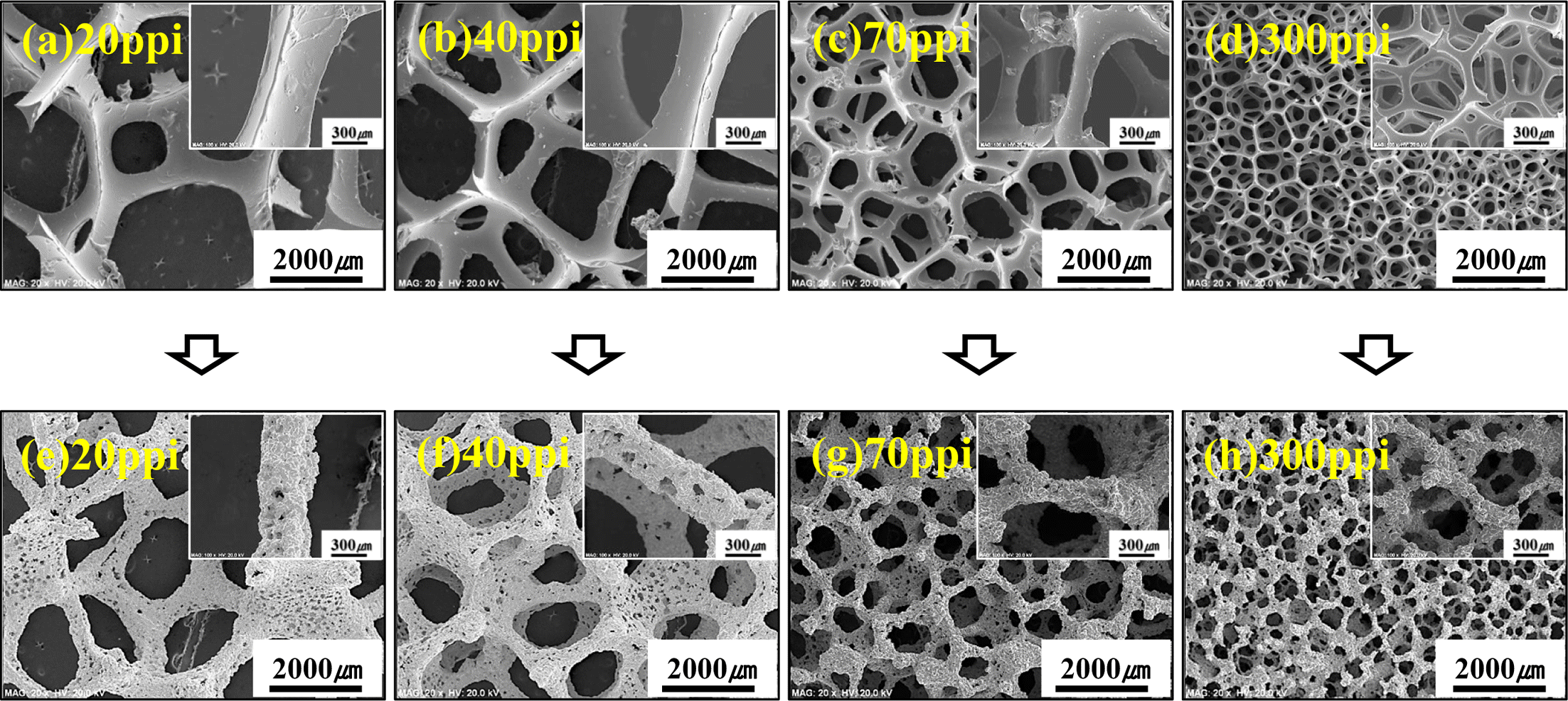

Fig. 1.
Flow chart of fabrication of Cu foam by a slurry coating process.
Fig. 2.
(a) SEM images of Cu powder at low (x100) and high (x1000) magnifications and X-ray diffraction patterns of (b) Cu raw powder and (c) Cu foam fabricated by a slurry coating process.
Fig. 3.
SEM images of Cu foam at low (x20) and high (x100) magnifications according to the coating times (a) 1 time, (b) 2 times, (c) 3 times, (d) 4 times, and (e) 5 times.
Fig. 4.
Pore characteristics of the Cu foam (a) pore size and strut thickness, (b) porosity, (c) flow rate as a function of differential pressure, and (d) cell size depending on the coating times.
Fig. 5.
SEM images at Low (x20) and high (x100) magnification of the type of PU foam (a) 20, (b) 40, (c) 70, and (d) 300 ppi and the coated Cu foam (e) 20, (f) 40, (g) 70, and (h) 300 ppi (pores per inch).
Fig. 6.
Pore characteristics of the Cu foam (a) pore size and strut thickness, (b) porosity, (c) flow rate as a function of differential pressure, and (d) cell size according to type of template.
Fig. 1.
Fig. 2.
Fig. 3.
Fig. 4.
Fig. 5.
Fig. 6.
Fabrication and Pore Characteristics of Cu Foam by Slurry Coating Process
TOP
 KPMI
KPMI



